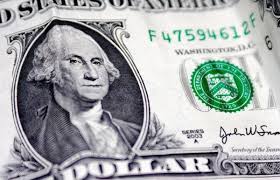U.S. dollar outlook darkens as trade war looms

The U.S. dollar could face headwinds if President Donald Trump’s proposals to impose stiff tariffs on steel and aluminium imports are enacted, with the biggest risk stemming from the possible flight of capital flows needed to finance ballooning U.S. deficits.
Currency markets, in general, dislike any form of trade intervention and previous protectionist efforts by the U.S. government have resulted in dollar weakness.
“The U.S. is now in a very precarious position because it’s putting a risk premium on U.S. assets by introducing tariffs and going down this protectionist route, which is negative for growth,” said Mark McCormick, head of North American FX strategy at TD Securities in Toronto.
The introduction of import tariffs threatens to increase the price of foreign products in the United States, reducing demand and imports.
Tariffs introduced by Presidents George W. Bush and Bill Clinton in 2002 and 1995 had resulted in a 15 percent decline in the dollar overall, according to estimates from TD Securities, although there were other factors that also undermined the U.S. currency during those periods.
The biggest risk for the dollar stems from the possible exodus of capital flows, analysts said. If risk sentiment worsens significantly, this would outweigh any short-term advantage the dollar would have against emerging markets in its role as a safe-haven bet, they said.
Trump said on Thursday duties of 25 percent on steel imports and 10 percent on aluminium would be formally announced next week, although White House officials later said some details still needed to be ironed out.
The dollar fell against most currencies after the announcement, falling to a more than two-year low versus the yen.
Trump’s comments have already caused an uproar in the international community, provoking a reaction from Canada, whose foreign affairs minister Chrystia Freeland said the country“will take responsive measures to defend its trade interests and workers.”
Other countries such were already looking at how to respond. Europe has drawn up a list of U.S. products on which to apply tariffs if Trump follows through on his plan
Analysts, meanwhile, are monitoring how China would react. China, while currently accounting for only a minor share of U.S. steel imports due to existing trade barriers, is by far the world’s largest producer.
Retaliation by other countries could prompt the withdrawal of capital flows from the United States at a time when the country has to finance its burgeoning twin deficits, analysts said.
The capital flow dynamic has changed over the last five to six years and countries such as China, Japan, and Europe have turned net creditors, pushing money overseas in search of the best-yielding asset.
On the other hand, the United States, while still the largest economy in the world, has become a net debtor, with current account and fiscal deficits seen exceeding more than 8 percent of gross domestic product over the next two years, analysts said.
Part of the expansion in the U.S. budget shortfall is attributed to the Trump administration’s tax overhaul and fiscal stimulus.
To bridge those deficits, the United States needs to borrow from overseas. Analysts said about 60 percent of U.S. deficits are funded by foreign countries or entities.
“The countries you’re basically having a trade war with — you’re basically poking China and Europe — are the countries that you will be relying on to finance your deficit,” said McCormick.
NEGATIVE FOR GROWTH
In addition, any impact on U.S. growth – though this is expected to be limited – could undercut the dollar, analysts said.
Andrew Hunter, U.S. economist at Capital Economics in London, said while the direct effect of tariffs may be minimal because steel and aluminium products account for just over 2 percent of overall imports, the“knock-on impact” on industries that use these products would be greater.
He added that domestic U.S. steel prices have already risen by 20 percent since the start the year in anticipation of protectionist measures and this could be a significant drag on steel consumers like the machinery, motor vehicle and construction industries.
“The Fed will presumably look through the temporary impact on inflation from higher imported steel prices, but it will find it harder to ignore any resulting upward pressure on wages and prices stemming from the increased demand among domestic (steel and aluminium) producers,” said Hunter.
This may yet be another reason to expect the Fed to raise interest rates four times this year. But some analysts said this may not necessarily boost the dollar since this outlook for interest rates is being driven not by expectations of stronger growth, but by fears of fiscal and political instability and inflation spiralling out of control.

